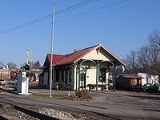
Pittsburg and Western Railroad
Encyclopedia
The Pittsburgh and Western Railroad (later Pittsburg and Western Railroad) was a nineteenth century narrow gauge railroad connecting Pittsburgh with coal supplies and the oil field around Titusville, Pennsylvania
. Its right-of way formed the main B&O line west from Pittsburgh. It was reorganized in 1889 under Malcolm A. McDonald.
The railroad constructed another narrow gauge line from Callery Junction
to Foxburg, Pennsylvania
. This became known as the Northern Subdivision. In 1883 the railroad took control of line from Foxburg to Mount Jewett
after the Pittsburgh, Bradford and Buffalo Railroad had financially flopped. The railroad would later merge with the Bradford, Bordell and Kinzua Railroad, and the Big Level and Kinzua Railroad. These mergers would prove to be ineffective, and by 1902 these joint railways were in financial ruin. In 1902, the Baltimore and Ohio Railroad
took control of the P&W. By 1911, the P&W was dissolved, and the B&O took over all operations. That same year, most of the narrow gauge was replaced
by standard gauge track. The B&O would continue to operate the line until 1982 when it was acquired by Sloan Cornell of the Knox and Kane Railroad
. Today, the line between the village of Ribold and Butler
, as well as the Petrolia Branch between Butler and Petrolia
is all that remains of the original Northern Subdivision that is still in operation. It is used by the Buffalo and Pittsburgh Railroad
. The section between Clarion Junction and Kane ceased operations in 2006 and was abandoned in 2008 when the Knox and Kane Railroad was sold at auction.
Titusville, Pennsylvania
Titusville is a city in Crawford County, Pennsylvania, United States. The population was 6,146 at the 2000 census. In 1859, oil was successfully drilled in Titusville, resulting in the birth of the modern oil industry.-History:...
. Its right-of way formed the main B&O line west from Pittsburgh. It was reorganized in 1889 under Malcolm A. McDonald.
The railroad constructed another narrow gauge line from Callery Junction
Callery, Pennsylvania
Callery is a borough in Butler County, Pennsylvania, United States. The population was 444 at the 2000 census.-Geography:Callery is located at ....
to Foxburg, Pennsylvania
Foxburg, Pennsylvania
Foxburg is a borough in Clarion County, Pennsylvania, United States. It is located along the east bank of the Allegheny River, about two miles north of its confluence with the Clarion River.-History:...
. This became known as the Northern Subdivision. In 1883 the railroad took control of line from Foxburg to Mount Jewett
Mount Jewett, Pennsylvania
Mount Jewett is a borough in McKean County, Pennsylvania, United States. The population was 1,070 at the 2000 census. The students of the borough attend school in the Kane Area School District, even though the borough is surrounded by Hamlin Township--belonging to neighboring Smethport Area School...
after the Pittsburgh, Bradford and Buffalo Railroad had financially flopped. The railroad would later merge with the Bradford, Bordell and Kinzua Railroad, and the Big Level and Kinzua Railroad. These mergers would prove to be ineffective, and by 1902 these joint railways were in financial ruin. In 1902, the Baltimore and Ohio Railroad
Baltimore and Ohio Railroad
The Baltimore and Ohio Railroad was one of the oldest railroads in the United States and the first common carrier railroad. It came into being mostly because the city of Baltimore wanted to compete with the newly constructed Erie Canal and another canal being proposed by Pennsylvania, which...
took control of the P&W. By 1911, the P&W was dissolved, and the B&O took over all operations. That same year, most of the narrow gauge was replaced
Gauge conversion
In rail transport, gauge conversion is the process of converting a railway from one rail gauge to another, through the alteration of the railway tracks...
by standard gauge track. The B&O would continue to operate the line until 1982 when it was acquired by Sloan Cornell of the Knox and Kane Railroad
Knox and Kane Railroad
The Knox and Kane Railroad was a short-line railroad in Pennsylvania that operated between Knox, in Clarion County, to Kane and then on to Mount Jewett, in McKean County.-Early years:...
. Today, the line between the village of Ribold and Butler
Butler, Pennsylvania
The city of Butler is the county seat of Butler County in the U.S. state of Pennsylvania, situated north of Pittsburgh. The population was 15,121 at the 2000 census.- History :...
, as well as the Petrolia Branch between Butler and Petrolia
Petrolia, Pennsylvania
Petrolia is a borough in Butler County, Pennsylvania, United States. The population was 218 at the 2000 census.-Geography:Petrolia is located at ....
is all that remains of the original Northern Subdivision that is still in operation. It is used by the Buffalo and Pittsburgh Railroad
Buffalo and Pittsburgh Railroad
The Buffalo and Pittsburgh Railroad is a Class II railroad operating in New York and Pennsylvania.The BPRR is owned by Genesee and Wyoming Industries. Its main line runs between Buffalo, New York and Eidenau, Pennsylvania, north of Pittsburgh. Here, connections are made to the city center via the...
. The section between Clarion Junction and Kane ceased operations in 2006 and was abandoned in 2008 when the Knox and Kane Railroad was sold at auction.
Sources
- Burns, Robert W., Ex-Baltimore & Ohio Lines in Northwestern Pennsylvania, Robert W. Burns, 1999.

